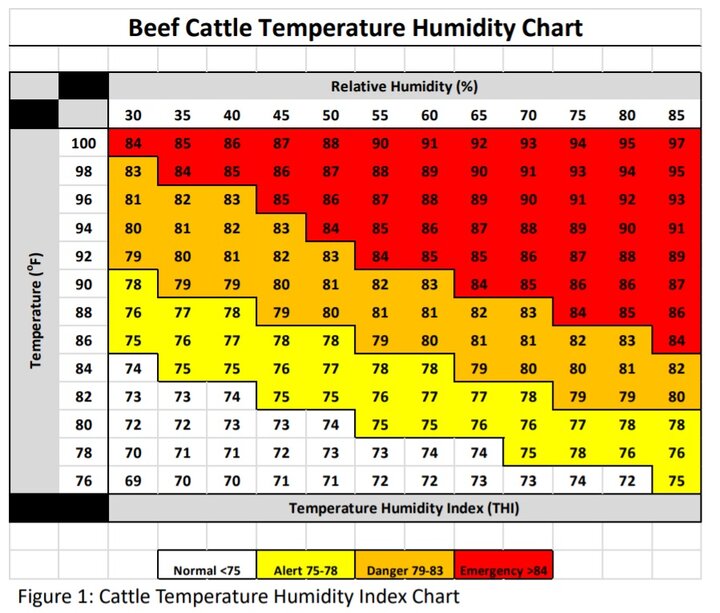The summer heat is bearing down across the nation. With the summer heat comes the concern for animal welfare, specifically towards cattle in feedlots. With rising temperatures and high humidity, cattle are more prone to heat stress. This concern increases when winds die down reducing air movement.
When cattle experience heat stress, producers may see reduced intakes and gains. However, in extreme cases, cattle can succumb to the detrimental effects of the heat stress they are experiencing.
Since cattle do not have very active sweat glands, they are unable to regulate their core body temperature like humans and other animals. Cattle must maintain normal body temperature to sustain essential physiological processes. Properly caring for and handling cattle includes supporting their temperature maintenance and ability to adapt to their regional environment.
The range of temperature in which cattle do not use additional energy to maintain core body temperature is referred to as the thermoneutral zone. This zone generally ranges from 32°F to 75°F for cattle but can vary depending on metabolic size. When temperatures exceed the upper critical temperature, cattle expend energy in attempt to dissipate heat. Panting and elevated respiration and heart rate are signs that this is occurring.
When temperatures are unable to drop below 70°F at night, cattle have no chance to decrease their core temperature and recover before the next episode of heat exposure.
Cattle producers must work to prevent or address environmental conditions that approach cattle’s heat thresholds to maintain optimal performance and health. Additionally, environmental conditions, even if not extreme, should be considered when deciding how and when to handle cattle.
One of the most critical times producers will need to implement strategies to prevent heat stress is when handling or transporting cattle. During these times, cattle will be experiencing a “double dose” of stress. Stress from handling and transport, and stress from the heat.
Beef Quality Assurance (BQA) guidelines suggest that producers should work to not handle or transport cattle between 11 a.m. and 4 p.m., the hottest hours of the day. However, the program understands that the beef industry does not stop because of a hot day. Therefore, the BQA program encourages beef producers to use precautions and implement strategies to best protect cattle during extreme heat events.
The best way for producers to determine when heat conditions have reached the point in which they need to implement strategies to reduce cattle heat stress is by using the Cattle Temperature Humidity Index (THI) (Figure 1). As an example, when the temperature is 98°F and the humidity is 30%, then the THI is 83, which is just inside the danger zone for cattle.

Producers should monitor weather frequently for potential heat events and keep an eye out for predicted temperatures in the high 80s and 90s, especially following a rain and in situations where the wind speed is going to be less than 5 mph for several days.
Avoid handling cattle when the risk of heat stress is high. When handling cattle, producers must consider temperature, humidity, wind speed, phenotype, and cattle acclimation. If cattle must be handled, BQA guidelines suggest producers do so before the THI exceeds 74. If cattle must be handled when the THI is ≤ 75, producers should use precautions.
Limit the amount of time cattle spend in handling facilities where heat stress may be more significant, and work cattle more prone to heat stress first, earlier in the day, or later if conditions are moderate; for example, process larger cattle during periods of lower THI.
When transporting cattle, a good practice is to reduce the load by 10% to improve air flow. Remember that when transporting cattle, limit the amount of time the animals are on the trailer and reduce the amount of time the trailer is not moving providing ventilation and air flow. For each one mile per hour increase in wind speed during transport, the THI decreases by approximately one point.
There are many other options for cattle producers to utilize in order to mitigate heat stress. These include:
- Providing plenty of water and space around water tanks for each animal. When the temperature is above 80°F, cattle require nearly twice as much water (up to 30 gallons per head per day).
- Sprinklers with a large droplet size can be effective in cooling cattle and pen surfaces in dry conditions; however, limit use when humidity and moisture are high.
- Removal of excess manure is critical. When manure builds up, it holds moisture and increases humidity.
- Bedding pens to help lower the temperature of the pen surface.
- Providing shade to reduce the heat load on cattle up to 20 degrees. However, it is important to have adequate space per animal to prevent overcrowding.
- Consider reducing the amount of feed delivered in the morning to help lower the heat load on cattle, starting the morning before a heat event occurs.
- Improve air flow by incorporating tall mounds and placing cattle in pens with fewer windbreaks in the summer.
Being proactive rather than reactive is important for avoiding any train wrecks when it comes to heat stress. For more information, see the Heat Stress Mitigation in Feedlot Cattle webinar https://beef.unl.edu/webinar/heat-stress-mitigation-feedlot-cattle or the Feedlot Heat Stress Information and Management Guide https://extensionpublications.unl.edu/assets/pdf/g2266.pdf.
Interviews with the authors of BeefWatch newsletter articles become available throughout the month of publication and are accessible at https://go.unl.edu/podcast.

